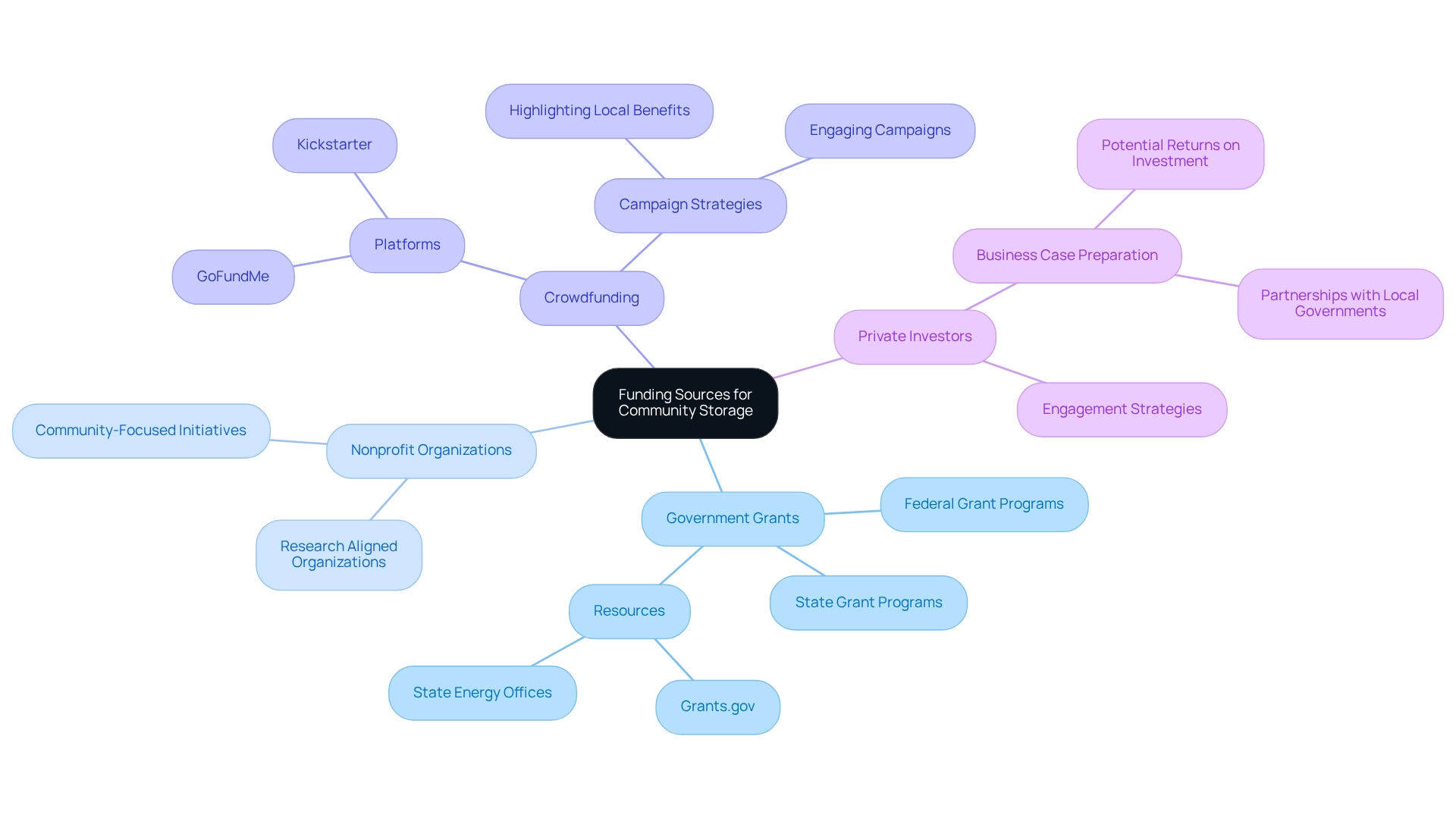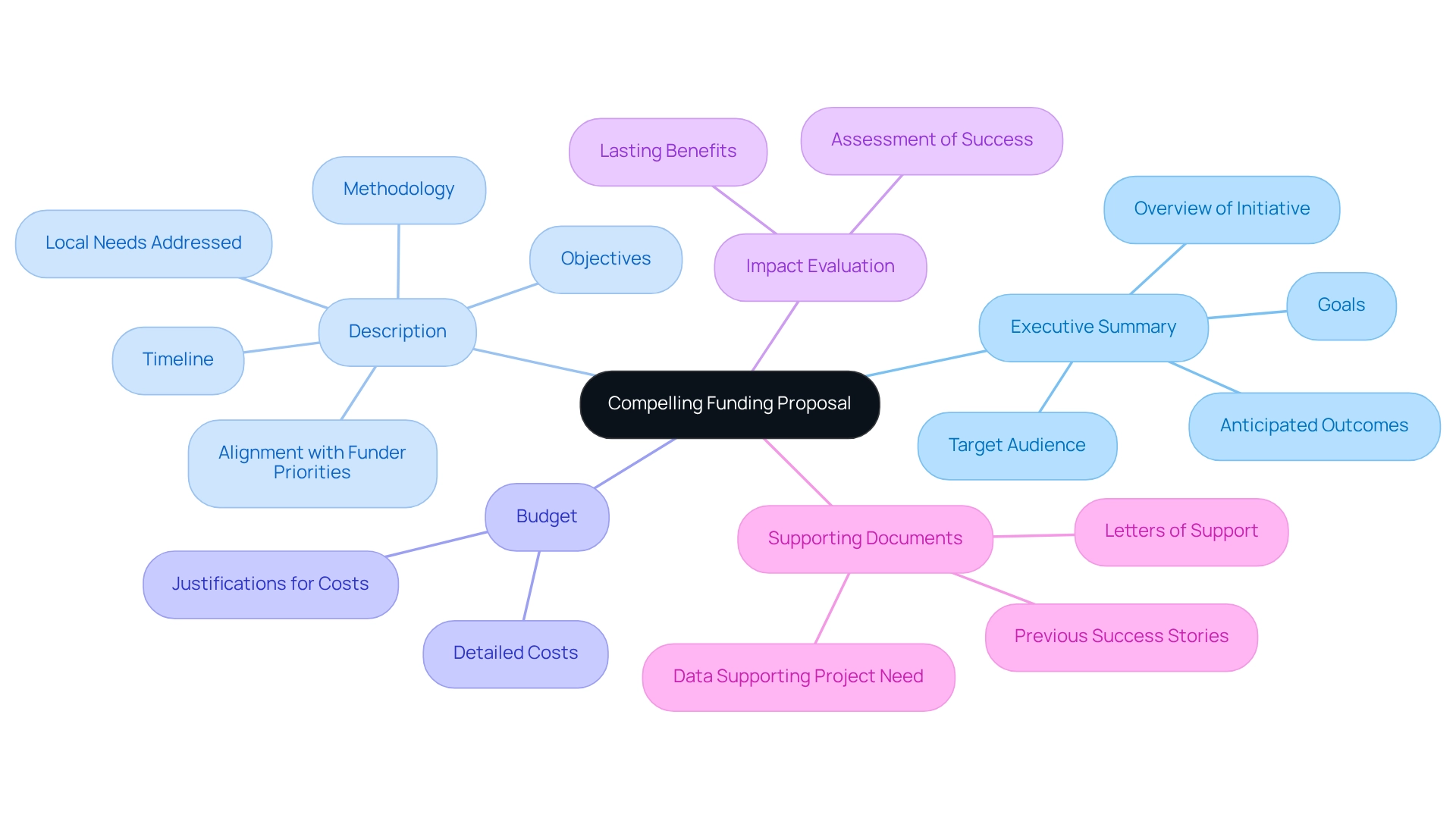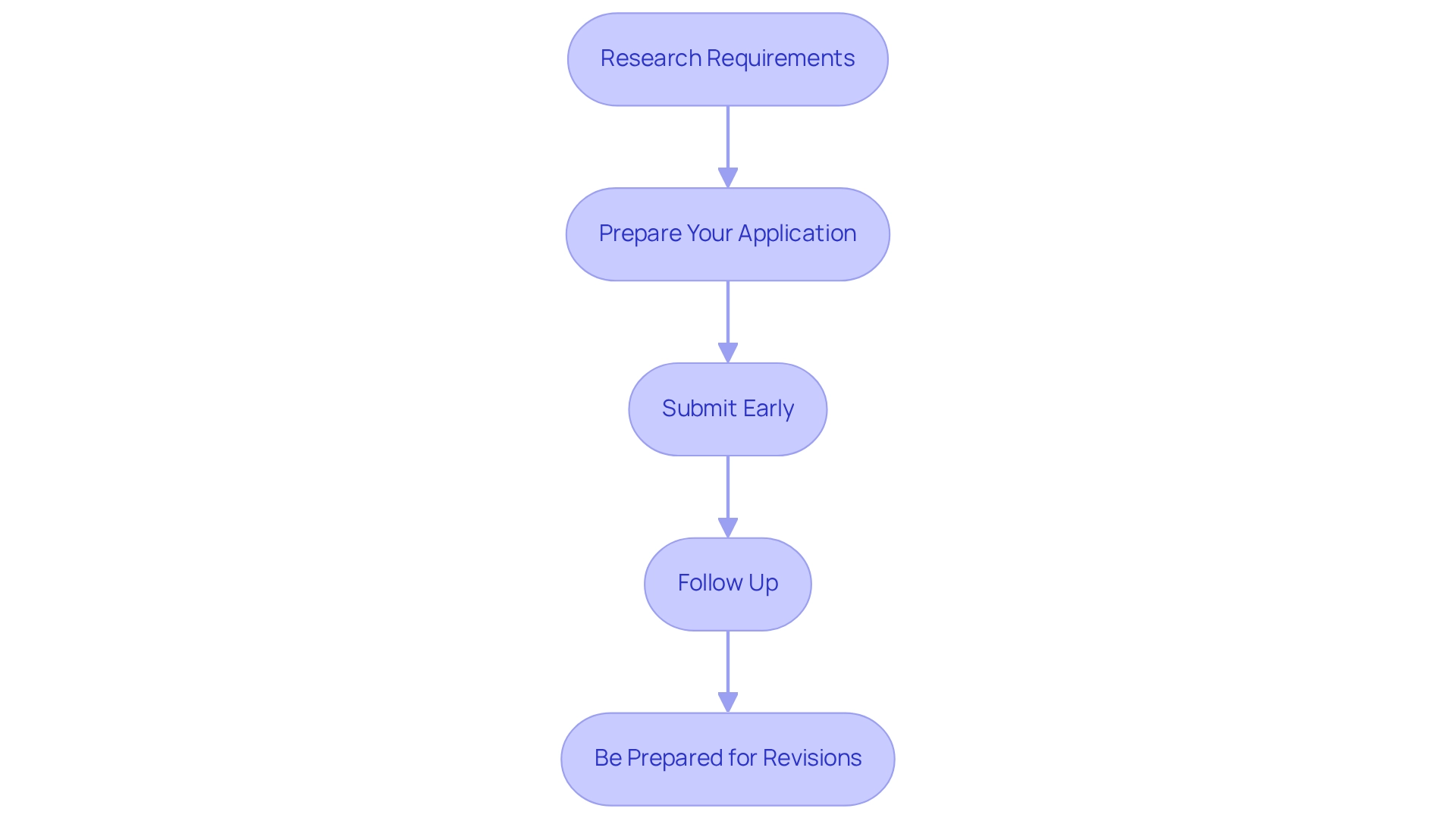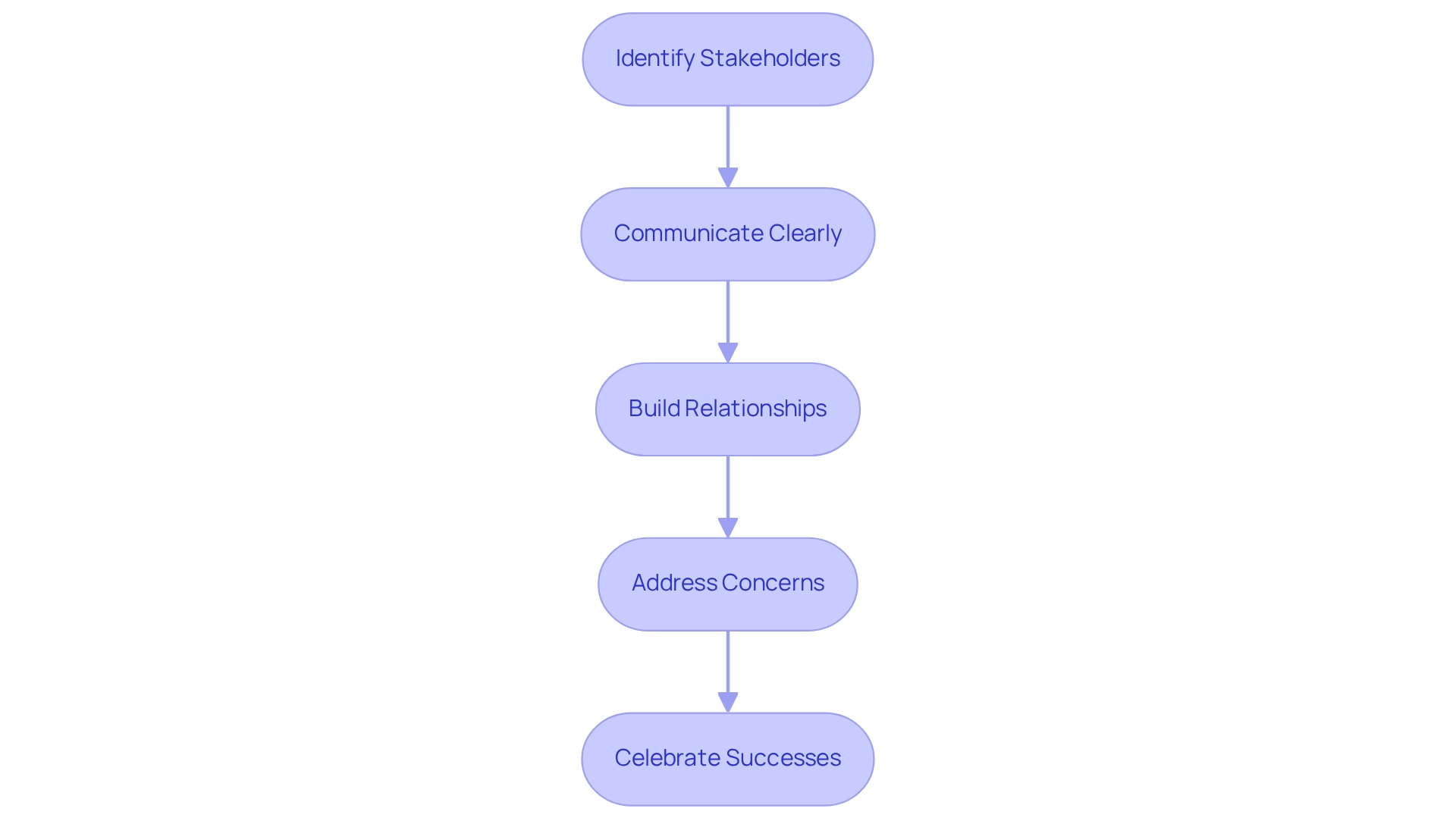Overview
This article delineates five essential steps to secure funding for community storage projects. These steps include:
- Defining the project's purpose
- Identifying funding sources
- Preparing a compelling proposal
- Navigating the application process
- Effectively engaging stakeholders
Each step is underpinned by detailed strategies and examples, highlighting the critical importance of understanding community needs. Furthermore, aligning the initiative with potential funders’ priorities significantly enhances the likelihood of successful funding acquisition.
Introduction
In an era where community collaboration is paramount, community storage projects emerge as innovative solutions to meet shared needs—be it energy, food security, or support for local businesses. These initiatives not only enhance resource management but also cultivate a sense of collective responsibility among residents.
However, the launch of such projects demands meticulous planning, encompassing the understanding of community needs and securing financial support. This article explores the crucial steps for successfully establishing community storage projects, including:
- Identifying funding sources
- Crafting compelling proposals
- Effectively engaging stakeholders
By examining these key elements, communities can unlock the potential of shared storage solutions and propel sustainable development.
Understand Community Storage Projects
Collective resource initiatives represent strategic efforts to deliver shared solutions for energy, food, or other assets within a community. These initiatives manifest in diverse forms, including battery storage systems for renewable energy, community storage project funding for food storage facilities, or shared warehousing for local enterprises. Grasping the specific objectives of your initiative is paramount. Consider these essential elements for the community storage project funding:
- Define the Purpose: Clarify whether your initiative seeks to bolster energy resilience, enhance food security, or support local businesses.
- Assess Community Needs: Engage in surveys or community meetings to collect insights on the most pressing needs for shared storage solutions.
- Evaluate Existing Resources: Analyze current storage capabilities to identify gaps that your initiative can effectively address.
- Understand Regulatory Requirements: Acquaint yourself with local regulations, including zoning laws and environmental considerations, that may impact your initiative, especially regarding community storage project funding.
By establishing a comprehensive understanding of these components, you can articulate the initiative's value more persuasively to potential funders.

Identify Funding Sources for Community Storage
Securing community storage project funding is crucial for its success. Consider these key sources to enhance your financial strategy:
- Government Grants: Investigate federal and state grant programs tailored for community development, energy efficiency, and sustainability. Websites such as Grants.gov and state energy offices serve as excellent starting points.
- Nonprofit Organizations: Numerous nonprofits are dedicated to supporting community-focused initiatives. Research organizations that align with your project's objectives to uncover potential funding opportunities.
- Crowdfunding: Leverage platforms like GoFundMe or Kickstarter to gather small contributions from a broad audience. Craft an engaging campaign that highlights the local benefits of your initiative.
- Private Investors: Engage with local businesses or investors who have a vested interest in community development. Prepare a compelling business case that clearly outlines the potential returns on investment, particularly emphasizing community storage project funding through partnerships with local governments or organizations that may provide access to financial support or resources beneficial to your project.

Prepare a Compelling Funding Proposal
Creating a compelling funding proposal requires several essential components:
- Executive Summary: Start with a succinct overview of your initiative, encompassing its goals, target audience, and anticipated outcomes.
- Description: Elaborate on the initiative’s objectives, methodology, and timeline. Clarify how it addresses local needs and aligns with funder priorities.
- Budget: Present a clear and realistic budget that details all expected costs. Provide justifications for each line item to demonstrate financial responsibility.
- Impact Evaluation: Describe how you will assess the success of the initiative and its lasting benefits to the local area.
- Supporting Documents: Include relevant documents such as letters of support from community leaders, data substantiating your project’s need, and any previous success stories.
Tailor your proposal to meet each funder’s specific requirements and priorities, thereby enhancing your chances of success.

Navigate the Funding Application Process
Navigating the funding application process can be intricate. However, by adhering to the following steps, you can simplify the journey:
- Research Requirements: Conduct a thorough review of the application guidelines for each funding source. Pay close attention to specific eligibility criteria, deadlines, and required documentation.
- Prepare Your Application: Gather all necessary documents, including your proposal, budget, and any supplementary materials. Ensure that everything is complete and formatted according to the funder's specifications.
- Submit Early: Aim to submit your application well ahead of the deadline to avoid last-minute complications. This proactive approach also allows time for any follow-up questions from the funder.
- Follow Up: After submission, consider reaching out to the funder to confirm receipt of your application and express your enthusiasm for the initiative. This can help keep your work top of mind.
- Be Prepared for Revisions: Some funders may request additional information or revisions. Embrace feedback and be ready to adjust your proposal as necessary.
By being organized and proactive, you can significantly enhance your chances of a successful application.

Engage Stakeholders Effectively
Effective stakeholder engagement is crucial for the success of any initiative. It involves several key strategies that can significantly enhance project outcomes:
- Identify Stakeholders: Determine who will be impacted by the initiative, including local residents, nearby businesses, government representatives, and possible financiers.
- Communicate Clearly: Develop a communication strategy that outlines how information regarding the initiative will be shared and feedback will be collected. Utilize various channels, such as public gatherings, newsletters, and social media, to reach a broader audience.
- Build Relationships: Foster trust by being transparent about objectives and challenges. Involve stakeholders in the planning process to ensure their voices are heard and valued.
- Address Concerns: Proactively address any concerns or objections stakeholders may have. Providing clear, factual information can help alleviate fears and build support for the initiative.
- Celebrate Successes: Regularly share milestones and achievements with stakeholders to maintain engagement and demonstrate the positive impact of the community storage project funding on the community.
By prioritizing stakeholder engagement, you can create a supportive environment that enhances the likelihood of securing funding and achieving project goals.

Conclusion
Community storage projects are essential for fostering collaboration and addressing shared needs within local communities. By identifying the specific goals of these initiatives—be it energy resilience, food security, or support for local businesses—communities can customize their strategies to effectively meet the needs of their residents.
Securing funding is a pivotal step in establishing these projects. By exploring diverse funding sources such as:
- government grants
- nonprofit organizations
- crowdfunding
- private investors
- partnerships
communities can significantly enhance their financial viability. Crafting a compelling funding proposal that articulates the project's objectives, budget, and expected impact is crucial for attracting the necessary support.
Moreover, effectively navigating the funding application process and engaging stakeholders are vital components of successful project implementation. By researching requirements, preparing thorough applications, and building robust relationships with community members and potential funders, project leaders can cultivate a supportive environment that encourages participation and investment.
Ultimately, community storage projects not only improve resource management but also foster a sense of collective responsibility. By embracing these initiatives, communities can unlock the potential for sustainable development, ensuring that today’s needs are met while paving the way for a more resilient future.
Frequently Asked Questions
What are collective resource initiatives?
Collective resource initiatives are strategic efforts aimed at delivering shared solutions for energy, food, or other assets within a community. They can take various forms, such as battery storage systems for renewable energy, funding for food storage facilities, or shared warehousing for local enterprises.
What are the essential elements to consider for community storage project funding?
The essential elements include: 1. Define the Purpose: Clarify the initiative's goals, such as enhancing energy resilience or food security. 2. Assess Community Needs: Collect insights through surveys or community meetings to understand pressing needs for shared storage solutions. 3. Evaluate Existing Resources: Analyze current storage capabilities to identify gaps that the initiative can address. 4. Understand Regulatory Requirements: Familiarize yourself with local regulations, including zoning laws and environmental considerations that may affect the initiative.
Why is it important to understand the components of a community storage initiative?
Understanding these components helps articulate the initiative's value more persuasively to potential funders, increasing the chances of securing necessary support.
What are some key sources for securing community storage project funding?
Key sources for funding include: - Government Grants: Explore federal and state grant programs focused on community development and sustainability. - Nonprofit Organizations: Research nonprofits that support community initiatives aligned with your project. - Crowdfunding: Use platforms like GoFundMe or Kickstarter to gather contributions from a broad audience. - Private Investors: Engage local businesses or investors interested in community development and prepare a compelling business case to attract their support.
How can I effectively present my community storage project to potential funders?
Prepare a compelling business case that clearly outlines the potential returns on investment, emphasizing the community benefits and partnerships with local governments or organizations that may provide additional resources or financial support.




